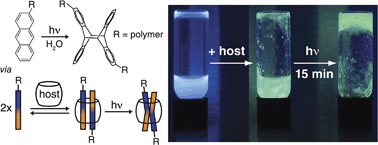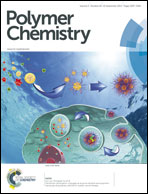Host–guest accelerated photodimerisation of anthracene-labeled macromolecules in water†
Abstract
The rate enhancement of the [4 + 4]-photodimerisation of anthracene through a host–guest templation strategy in water is presented and applied to polymer ligation and cross-linking. The macrocycle cucurbit[8]uril (CB[8]) tethers together two anthracene moieties in a face-to-face π–π-stack arrangement, which results in significantly faster photochemical dimerisation (on the order of a few minutes) than in the absence of the host, minimises photochemical side reactions and works even under dilute conditions. Therefore, the host-accelerated photodimerisation was applied to macromolecules, shown here for anthracene end-group functionalised poly(ethylene glycol) (PEG) and side-chain functionalised hydroxyethyl cellulose (HEC) to induce polymer-ligation and network-formation (hydrogelation), respectively. In particular, only in the presence of CB[8] did polymer-ligation or chemical cross-linking through photodimerisation occur, whereas photochemical degradation reactions were exclusively observed in the absence of the CB[8] host.


 Please wait while we load your content...
Please wait while we load your content...